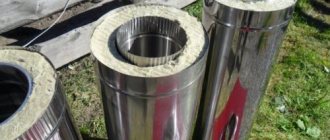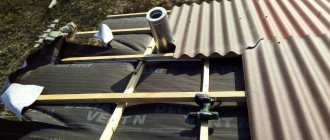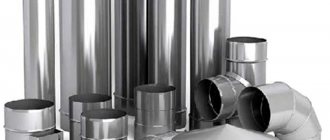A small device - a net for stones on a pipe in a bathhouse - may seem like something primitive and unnecessary; the stove copes well with heating the room even without homemade attachments. But the secret is that a hot chimney pipe can overheat the air in the steam room and saturate it with the smell of burnt metal, so a grate for the stove in the bathhouse is considered as one of the ways to improve the microclimate in the steam room.
What does a mesh for stones give to a sauna stove?
Structurally, the device looks quite simple and unpretentious. Typically, a mesh for stones on a stove is a cylindrical wire or reinforcement frame welded from metal, placed on a chimney and filled with rock fill of a suitable size.
Installing a mesh for stones on a pipe in a bathhouse allows you to solve several problems at the same time:
- Reduce the heating intensity of the upper layers in the steam room of the bath. Anyone who has had to steam with a stove whose chimney was left without a cover and without a mesh for stones knows how scalding the hot metal of the pipe can be;
- Redistribute the heat in the bath. In the classic version, the grate for stones in the bathhouse is installed on the metal body of the stove, which is not always justified. The lower layers of air in the steam room remain cold, 40-45°C, while the ceiling heats up to 80°C;
- When properly arranged, the mesh on the pipe for stones perfectly performs the functions of a heater; often more steam is obtained than when the backfill is placed on the walls of the firebox.
The only drawback is the high location of the mesh box on the chimney. For tall people, as a rule, there are no problems; for others, you need to be as careful as possible so as not to get burned by the hot steam.
For your information! In this case, the mesh on the chimney does not protect the metal of the pipe from oxidation or burning, so you cannot replace stainless heat-resistant steel with cheaper carbon structural steel.
The heater mesh on the pipe, when regularly scalding the backfill with boiling water, reduces the temperature of the chimney walls, so the metal burns less than when the steel is covered in thermal insulation.
Selection of stones and their placement
Stones must be selected from diabase , soapstone or crimson quartzite . They not only have a beautiful appearance, but are also durable. Many people choose river pebbles for their heaters. In this case, you need to take into account that it must be a certain size. And before laying, be sure to wash all the stones.
The process of laying stones can be called throwing. You need to take four large stones of the same size and place them in four different directions around the pipe. This will make the product equidistant. Then the remaining stones can be thrown on top of these.
Over time, due to the effects of temperature, the mesh may become deformed, and the stones in it may sag. To prevent this from happening, you need to choose a calibrated stone or, in other words, so that it is equal in size to the width between the pipe and the product. also better to choose a round stone . This way it can form an even layer around the pipe. Small stones will help close the space between large stones.
At first glance, a heater made by yourself may turn out to be inconspicuous, but you should not pay attention to this, because the main thing is not beauty, but benefit. Over time, you can transform it and it will last for many years.
What to choose, popular models
When choosing a specific model of stone mesh for the chimney, two conditions must be taken into account:
- The location of the stove in the steam room of the bath;
- The height of the free part of the chimney;
- Average and maximum furnace performance.
For example, if the stove is located against a wall or in a corner of the room, then the best option for a grate for stones on a pipe would be a semi-closed design with a blank rear part and slotted walls, photo.
If the chimney in the steam room is exhausted through the wall, a horizontal version of the mesh container will be required.
Most often, for chimney pipes of non-standard shape, the mesh for the stove in the bathhouse is made individually, to order or with your own hands. In addition, it will be necessary to provide additional fastening, since the strength of the chimney will clearly not be enough to hold a container with stones weighing 20-40 kg.
For a narrow and tall steam room, the mesh for stones on the chimney is made elongated, like a candle. This design is safer in tight spaces in the bathhouse.
Stone nozzles are made with perforated walls, in the form of rectangular and round containers.
Sometimes the container for the stone is designed in the form of a figured structure with forged rods. For cast iron stoves, it is allowed to install grids with a volume of no more than 35 liters, for steel structures - no more than 25 liters.
Limitations on the use of metal for a mesh frame
To make a mesh container you cannot use:
- Galvanized or painted wire, coated with PVC, polyester resins;
- Aluminum and bronze mesh wire meshes used in industrial chimneys and exhaust pipes as soot traps and spark arresters;
- Containers cannot be made from dissimilar materials that form galvanic couples, for example, aluminum-steel, copper-aluminium.
Such a mesh for pipes for stones made of non-ferrous metals quickly corrodes in the humid atmosphere of a steam room and often crumbles just before our eyes.
For a medium-sized sauna stove, you will need a mesh that can hold up to 20 liters of stone backfill. Since the stones used in the backfill are quite large, after placing the material in the mesh basket, an imbalance will inevitably arise, deflecting the container away from the chimney.
Therefore, the design must have at least two clamps that secure the mesh to the chimney. If small stone is used for backfilling, then the mesh should have a cell size of at least 10 mm. It is unsafe to use finer filler; the material produces very powerful steam, and sometimes the resulting fragments and screenings spill out through the mesh onto the floor of the steam room.
Materials and manufacturing methods
Most often, the basket follows the shape of the stove and is assembled using electric welding. Popular profiles for its production are a strip 2-4 mm thick and 30-40 mm wide, a square 8x8 and 10x10, and a round rod. Materials: structural and stainless steel.
The first one should be additionally coated with heat-resistant paint, since superheated steam, which will be in excess, will quickly render the product unusable. Those who have forging skills and make exclusive designer baskets most often assemble them using rivets or forge welding.
For stoves with round fireboxes, a mesh is often made from expanded stainless steel sheet 2 mm thick. It is rolled onto a pipe or other cylindrical surface of suitable diameter, and the edges are fastened with knitting wire.
You should not weave a wire mesh or use a ready-made chain-link. Those who have tried it say that the structure quickly loses its shape under the influence of temperature and the weight of the stones. You should also avoid using dissimilar metals, for example, stainless steel and copper, which form galvanic couples: electrochemical corrosion will destroy them very quickly.
Which type of basket for stones is better?
One of the most effective heater models is shown in the diagram. The height of the mesh body is 66 cm, the diameter is selected depending on the cross-section of the chimney.
The above design with a conical perforated bottom, according to the manufacturers, effectively warms the air, even without spraying the stones with boiling water. Hot air rising from the oven penetrates through the bottom holes into the mesh container and warms up to a temperature of more than 100°C.
Experts recommend purchasing meshes with a minimum number of welding seams.
Do-it-yourself pipe mesh for stones
The easiest way is to make a basket for stove stones from ordinary welded mesh pergons. Thin, 2.5 mm wire easily bends into a cylinder of any diameter. Cell size 40x40 mm.
For a container with a diameter of 300 mm, you will need to cut a sheet 1200 mm wide and 600 mm long. The workpiece is carefully bent on a wooden frame and fixed with soft winding wire.
This mesh is installed on the chimney pipe and filled with stone only once. After use for several months, the wire of the basket burns out and becomes soft, after which the mesh shell quickly loses its original shape.
If you don’t have a mesh fabric with the appropriate mesh size at hand, you can assemble the basket by laying two or three layers in spiral winding. The edges of the shell are trimmed and aligned to length.
To give additional rigidity and strength to the relatively soft mesh shell, rings bent from thin strips of stainless steel are placed on the edges of the basket. The metal thickness of the hoop must be at least 1.5 mm, the width of the tape is 35-40 mm.
To fasten the stone mesh to the pipe, two detachable steel clamps are installed inside the mesh with a bolted connection. The diameter of the lower clamp is selected according to the diameter of the chimney outlet glass, the cross section of the middle or upper is determined by the vertical section.
In addition, an additional pin is often installed on the middle clamp, with which a pipe or mesh with stones can be secured to the wall of the steam room.
Mesh cladding
It is not necessary to build a basket from mesh fabric; often, any material at hand is used to make the container. The main thing is that the metal should be resistant to hot water vapor and at the same time be sufficiently ductile.
For example, the ideal material for making a container for a pipe is a metal mesh from a radiator or a fence made of a perforated stainless steel sheet. A stove with a power of 5-7 kW will require a small sheet of perforated steel measuring 60x100 cm.
If desired, perforation can be done independently, for example, using a drill with drills of different diameters. In this case, a mesh for stones looks more impressive than one welded from wire.
The workpiece is smoothly bent on a wooden mandrel, so that the opposite edges of the sheet overlap along the seam line.
The joint can be joined using carbon dioxide welding or rivets, but before this you will need to align and trim the edges of the seam. Mounting clamps are installed inside the stone mesh, and the bottom part is covered with a partition made of a single sheet. It is especially important to seal the lower part if the heater is intended to be installed on a cast iron stove.
Is it possible to get good steam from the net?
Pay attention to the design of the stoves in the Domna-Setka line produced by us. You can remove a huge amount of steam from it. When designing, we focused on the aesthetics of natural stone, but did not forget about functionality. In our stoves, only the side surfaces of the firebox are covered with mesh, which emit soft heat. The front and rear walls are convection casings. We kept the closed heater in these stoves. It is from them that you will get the perfect light vapor.
Another interesting solution is represented by the Sibirsky Utes stoves. You can remove steam without waiting for the heater to fully warm up, and the built-in steam generator makes it easy to achieve the required humidity.
Source of the article: https://zen.yandex.ru/media/pechi_teplodar/setka-dlia-kamnei-dlia-bannoi-pechi-svoimi-rukami-5cc7c9453e66cc00af049fb1











